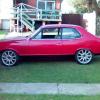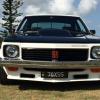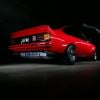I'm using 2.5" Corvette Rams Horns in the HK. Where is the best place to put the O2 sensor with these? After the bend? Remember these point straight down so I have to do a 90deg sweep in the 2.5" pipe then it heads back to a pair of resonators in the original HK dual exhaust location.

Ultimate street carb choice for warm 383 SBC
#26

Posted 25 September 2020 - 02:04 PM
#27

Posted 26 September 2020 - 10:43 AM
Asked on another forum copy/paste answer was 18 inches from exhaust port basically meant where all ports for that side meet together to account for rich/lean average...
Only asked as most of my pacies have 02 sensor bung first y join close to head from factory & read that not most accurate readings for guage.
#28

Posted 29 September 2020 - 12:00 PM
So much good info in this thread, great reading.
I've done some more research on the air:fuel monitoring, and noting the earlier replies - I've got it down to the following 2 options from Innovate:
Option 1 - MTX-L Plus.
Option 2 - DB series. Offering a blue gauge, this would look great in my car. It also comes with a the LC-2 (which the MTX-L doesn't).
Either of these kits will meet my current needs to log the air:fuel ratio in 'real time'. And the prices are identical at around $350.
Is there any functional advantage to having the LC-2?
The only thing I could see myself wanting to do in the future, would be to capture the RPM, and then log RPM and Air:Fuel at the drag-strip, just to see what the car does during the run (when I'm trying to look out the windscreen and not at the gauge).
How would I go about achieving that with either of the above mentioned kits? (i.e. what else would I need to buy to capture RPM)?
Here's the 2 choices:
 MTX-L.JPG 49.95K
3 downloads
MTX-L.JPG 49.95K
3 downloads
 DB.JPG 106.91K
4 downloads
DB.JPG 106.91K
4 downloads
Edited by LXCHEV, 29 September 2020 - 12:00 PM.
#29

Posted 29 September 2020 - 03:09 PM
Hard to tell from their web site, but it seems to me that the MTX-L basically has the controller integrated into the gauge itself and no separate physical components other than the sensor. Whereas the DB series is a dumb analog gauge meant to be used with a standalone controller such as the LC-2. Other than that it appears both have basically the same functionality so it really depends on whether you have situations where you want to use the wideband without the gauge, and/or whether you want to do some additional wiring or more custom integration.
My understanding you need an additional module to support datalogging with other sensors, e.g.:
https://innovatemoto...roducts/pl1.php
Take a look at the "example log chains" image to see how devices go together. You would attach the output of your wideband controller to the datalogger along with a suitable RPM sensor (possibly just a tach signal?). Its not quite like an EFI application where the ECU provides all this additional functionality.
#30

Posted 29 September 2020 - 08:08 PM
Yeah it's not 100% clear to me, but looking at those example log chains, a pocket logger works with both the MTX-L and DB series, so I don't think either choice will limit me from expanding further down the track. Agreed - it seems the MTX-L has the controller component fully integrated into the gauge itself, so it's perhaps a little cleaner/simpler than the DB series.
Tough choice, I'm still torn!
#31

Posted 29 September 2020 - 10:59 PM
Aim a gopro at it when racing down the strip althoough you'd want to see tacho as well just to see at what rpm etc things happen or improved upon.
Personally think if you get air/fuel ratio right for street driving & make it responsive it will only help it more at track.
#32

Posted 30 September 2020 - 05:11 AM
A carb only has a few different circuits and is self-correcting (fuel has to follow airflow) beyond that, so is relatively simple to tune with minimal data points. I find that being aware of what the throttle is doing and simply knowing which circuit is being used at the time you see a poor reading allows you to improve the tune very quickly and get good results. The tuning process is no different to normal, you still need to start with the appropriate circuits and be systematic but the wideband feedback speeds things up considerably even without any datalogging.
Yes the MTX-L would be simpler to install (and that's probably the point) but the standalone controller perhaps a little more flexible if you want to use it for different applications. I suspect the hardware hidden inside is probably much the same so either will do the same job.
#33

Posted 30 September 2020 - 07:07 AM
I've gone down the road less travelled with carburettors.
My motor was built for say "club circuit" but in reality it's doing street cruiser duties most of the time.
Group A block stroked, 372 cubes with ported YT-3 heads, Crane roller cam 242-250. Comp 11.3-1, NGK BP7FS plugs.TP single high rise etc. Initially with a Quick Fuel road/race 750 square bore. Run in dyno figures were 480 ft-lb @ 5000 & 530 HP @ 6800 rpm on PULP.
As for street duties, it wasn't very happy. Plugs would foul up in no time. I put hotter NGK BP BP6FS plugs in. Got Ross from Carbo-Tune to change jets, drill out air bleeds, road tune etc. It performed better but the problem was still apparent. I persisted with the QF for a couple years but eventually got the shits. Ross suggested putting my VL 603 Rochester on but after he does his modifications & recalibrate it to suit my motor.
What a difference!! No more fouled plugs. It's crisp & responsive and wants to go where before it was trying to catch up to the over-fuelling QF. Don't get me wrong the QF 750 is probably best suited for those club circuit days at WOT but for the street, not worth the trouble.
The Quadra-jet is perfect for driving duties but he said he motor could lose about 20 horsepower at the top rpm range. We found a little more torque though.
I'm very happy with the Rochester. I asked Ross why people ditch them for the Holley style square bore? He said most people don't to understand the Rochester so therefore run with the rest of the herd. Well there you go..
 IMG_2374.jpg 122.41K
6 downloads
IMG_2374.jpg 122.41K
6 downloads
#34

Posted 30 September 2020 - 07:42 AM
#35

Posted 30 September 2020 - 02:47 PM
Ando - a couple of very interesting points there. Firstly - I actually had a Quaddie on my 383 about 20 years ago when I first did my chev conversion. It was an excellent carb, with no fouling issues ever. The issue I had was maintaining fuel pressure supply. I had a mechanical pump (6 valve) and 1/2" supply line initially. I played with electric pumps for a few years too, before going full circle back to a mechanical again (I love their simplicity).
During those earlier years though, I had moved to the Holley/BG 4 barrel style of carbs purely because of my interests in drag racing at that point in time (I was a regular at the drag strips and pretty keen for a short while). These days, I'm back to street cruising with the family - hence why I'm now so interested in refining my setup/tune.
Question for you - what kind of fuel supply/system are you running to keep that quaddie happy whilst still providing over 500HP? That's damn impressive. Have you ever experienced any fuel starvation issues?
Moving on to spark plugs - in my racing days, I have also used the NGK BP7FS (2 heat ranges colder than standard)... but generally run the BP6FS now. I've actually been told to try moving right back to BP5FS and see if that helps clean up my plugs. Something I've never considered, but really keen to try now. Maybe 5's on the street, and if I ever did hit the strip, I could run the 6's.
What are people's thoughts on standard heat range plugs for something making HP in the mid-400's? At whiat point do you need to shift to a colder plug?
76lxhatch - your points make perfect sense and I'm super keen to do exactly that - understand each stage of the carb circuitry, and then refine it accordingly.
#36

Posted 30 September 2020 - 05:53 PM
Len, I like doing things a little unconventional. I had nothing to lose trying the Q-jet. Getting a somewhat linear AFR on carburettor's can be tricky. Spark control is basically a re-curved 12 V Bosch HEI to suit the cam, (no fancy multi spark module here). It took a couple road runs to get it sorted. I had to be Ross's ears because he's a bit deaf these days lol.
Brett I'm a believer in simplicity as well. I installed 1/2 fuel line up to the AC mechanical fuel pump but still retained 5/16" factory sender in the drop tank. The pump is rebuilt using the OZ Race 4 valve base. They run on the standard 6-7 pound pressure. This was all set up for the QF 750 initially. When we swapped to the Q-jet, I had to reduce to 3/8" fuel line from the pump to the carb. Ross drilled a out the carb fuel entry hole size. One of his tricks is to maximise fuel volume in the carb body. I wont go into what else he does as it not my place to say so but that's basically the fuel delivery up to the carb.
Ross did pick up that I was a bit heavy on the pedal when driving so I changed my driving habit. I now "feed in" as opposed to "stomping the gas". That made a world of difference with the fuel circuits transitioning from one to the other. The motor is built to handle 7000 + rpm & so far, no fuel starvation to report.
As with the plugs the 6 heat range seems to work best with the Q-jet. I'd be reluctant to go hotter with this motor. If I was to do a circuit day then the QF 750 would go on & I'd use the cooler 7 plugs. For a short time, I did run BP5FS plugs with the over fuelling QF 750 but that was trying to band aid the plug fouling problem.
Hope this made sense.
#37

Posted 30 September 2020 - 06:39 PM
Makes great sense. I've heard there's quite a few tricks with modifying quaddies, so it's really interesting hearing of stories like yours with serious HP engines - and making it all work.
If I can't get my Holley right, I may indeed shelve it for 'race duties' and then 'quaddie it up' for street duties. But I'm keen to try first and see where I can get with it.
Back to plugs - I'm making considerably less power than you, so may still try the 5's for a bit and see how they behave.
#38

Posted 17 November 2020 - 11:12 PM
Well I bit the bullet and replaced my 750 Ultra HP for a.... wait for it...... 650 Street HP!
I've posted some results up in my build thread here for anyone keen to follow my progress (scroll down to post #392)....
Edited by LXCHEV, 17 November 2020 - 11:14 PM.
0 user(s) are reading this topic
0 members, 0 guests, 0 anonymous users





 View Garage
View Garage










